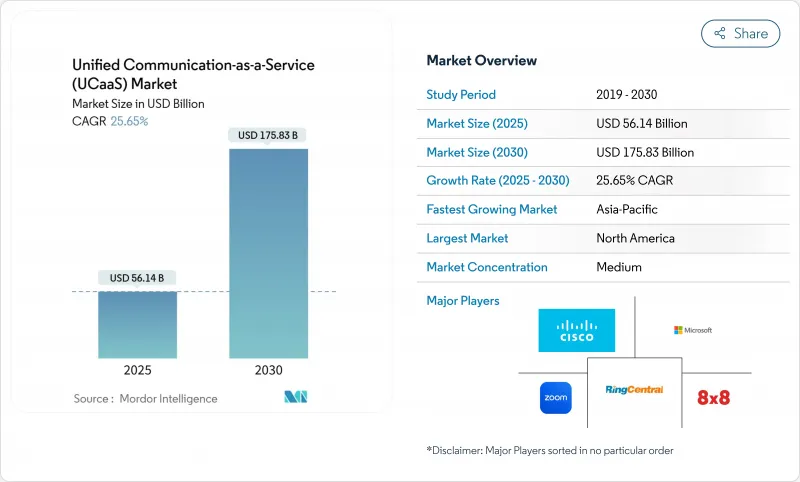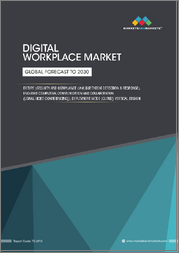
|
시장보고서
상품코드
1849852
UCaaS(Unified Communication as a Service) : 시장 점유율 분석, 산업 동향, 통계, 성장 예측(2025-2030년)Unified Communication-as-a-Service (UCaaS) - Market Share Analysis, Industry Trends & Statistics, Growth Forecasts (2025 - 2030) |
||||||
UCaaS(Unified Communication as a Service) 시장의 2025년 시장 규모는 561억 4,000만 달러로, 2030년에는 1,758억 3,000만 달러에 이를 것으로 예측되며, CAGR은 25.65%를 나타낼 전망입니다.

이 급증은 단편화된 커뮤니케이션 툴의 기업 전체 통합, AI를 활용한 생산성 기능에 의한 측정 가능한 ROI, 기본적인 음성의 대체를 훨씬 넘은 클라우드 텔레포니 채용의 변곡점에 의해 촉진되고 있습니다. 북미 기업이 여전히 가장 규모가 큰 지역 점유율을 차지하고 있지만, 아시아태평양은 5G 네트워크와 모바일 우선 전략을 통해 최전선 이용 사례를 해방하고 2자리 성장률로 성장하고 있습니다. 대기업은 여전히 주요 수익 공헌자이지만, 비용에 민감한 중소기업은 내결함성을 강화하면서 자본 지출에서 해방되는 종량 과금 모델을 채택하고 있습니다. UCaaS를 CCaaS 및 CPaaS와 통합하는 공급업체는 지갑 공유를 확장하고 보안 주도 지역 데이터 레지던시 프레임워크는 세계 배포를 형성하는 기본 요구 사항이 되고 있습니다.
세계의 UCaaS(Unified Communication as a Service) 시장 동향과 인사이트
종량 과금의 OPEX 모델이 비용 중시의 중소기업을 끌어들인다.
호스팅형 UCaaS 솔루션을 통해 중소기업은 자본 부담이 큰 PBX 시스템을 예측 가능한 월별 요금으로 대체할 수 있어 구내 전화에 비해 최대 55%의 비용 절감이 가능합니다. 그 결과 중소기업은 가장 빠르게 성장하는 사용자층이 되고, 2024년부터 2030년까지의 CAGR은 27.8%를 나타낼 전망입니다. 중소기업의 51.3%는 사이버 방어를 최우선 기술로 삼아 엔터프라이즈급 클라우드 방어가 사내 방어보다 우수하다고 생각합니다. 특히 아시아태평양과 라틴아메리카의 신흥국에서 도입이 진행되고 있으며, 현지의 접속 파트너가 음성, 비디오, 메시징과 5G 모바일 액세스를 번들해 풀 매니지드 서비스를 제공합니다.
리모트 워크와 하이브리드 워크의 방침이 어디에서나 근무 수요를 강화
고용주의 91%가 플렉스제를 도입했으며 회의의 98%가 적어도 한 명은 원격으로 참가하고 있습니다. 음성, 비디오, 채팅 및 파일 공유를 통합한 플랫폼은 재량적인 도구가 아니라 미션 크리티컬한 인프라입니다. 직원은 여러 앱을 사용해야 하며 하루에 36분의 시간을 잃어버리므로 CIO는 중복 서비스를 통합해야 합니다. 북미 기업은 스피커의 자동 프레이밍과 라이브 캡션을 생성하는 AI 지원 디바이스로 시대 지연 회의실을 근대화하고 유럽 기업은 GDPR(EU 개인정보보호규정)에 준거한 프라이버시 주도의 데이터 처리를 중시하고 있습니다.
멀티 벤더 UC 스택의 스킬 갭이 마이그레이션 사이클을 길게 만듭니다.
기업은 클라우드 네이티브 음성 엔지니어와 API 통합 전문가 부족을 마이그레이션의 주요 장애로 꼽고 있으며 IT 리더의 62%가 지연을 보고하고 있습니다. 대규모 기업에서는 레거시 PBX, SIP 트렁킹, 새로운 AI 서비스를 가동 중지 시간 없이 통합하는 데 어려움을 겪고 있으며 비용이 많이 드는 시스템 통합사업자에 의존할 수밖에 없습니다. 이 병목 현상은 특히 은행과 건강 관리에서 두드러지며, 보안 모니터링이 프로젝트 일정을 연장하고 있습니다.
부문 분석
2024년 UCaaS(Unified Communication as a Service) 시장 점유율은 텔레포니가 38.3%를 차지했지만 협업 플랫폼은 28.3%의 연평균 복합 성장률(CAGR)로 성장하고 있으며 음성 단체에서 통합된 비디오, 채팅, 컨텐츠 공유에 대한 축족을 반영합니다. CIO가 생산성 향상을 추구하는 동안 통합 메시징과 다인원 회의 도구는 지속적인 예산 우선순위를 확보하고 있습니다. 라이브 번역, 실시간 화이트보드, 자동화된 액션 추적 등 회의를 기업 지식으로 바꾸는 AI 강화 기능에 대한 투자가 진행되고 있습니다.
협업 플랫폼의 UCaaS(Unified Communication as a Service) 시장 규모는 모든 업종의 채택을 반영하여 2030년까지 820억 달러에 이를 것으로 예측됩니다. 텔레포니는 규제 대상인 통화 녹음 및 긴급 서비스에 여전히 필수적이지만, 상품화의 압력은 근본적입니다. 공급업체는 임베디드 분석, 서비스 품질 보증 및 공공 기관의 요구 사항을 충족하는 지역 데이터 레지던시를 통해 차별화를 도모하고 있습니다.
UCaaS(Unified Communication as a Service) 시장은 구성 요소별(텔레포니, 유니파이드 메시징 등), 최종 사용자 기업 규모별(대기업, 중소기업), 업계별(은행, 금융서비스 및 보험(BFSI), 소매 및 E-Commerce, 교육 등), 지역별로 분류되어 있습니다. 시장 예측은 금액(달러)으로 제공됩니다.
지역별 분석
북미는 광범위한 클라우드 성숙도, 견고한 광대역 인프라, Microsoft Teams 정착으로 2024년 매출 점유율 43.4%로 UCaaS(Unified Communication as a Service) 시장을 선도했습니다. 미국은 FedRAMP 인증을 받은 제품에 의해 공공 부문과의 계약이 해제되어 더욱 이익을 누리고 있습니다. 보급이 포화 상태에 가까워짐에 따라 성장은 2자리대 전반으로 둔화되고 있지만, AI 통합, 컨택 센터 통합, 프런트 워커용 솔루션이 지출의 기세를 유지하고 있습니다.
유럽에서는 영국, 독일, 프랑스에서 꾸준히 도입이 진행되고 있습니다. GDPR(EU 개인정보보호규정), 디지털 시장법, 임박한 국가의 클라우드 규제로 기업은 현지 데이터센터와 크로스 플랫폼 상호 운용성을 갖춘 공급자를 선호합니다. 독립 서비스 제공업체는 특히 의료 및 행정 분야에서 언어 요구사항 및 수직 컴플라이언스 규칙에 맞는 솔루션을 제공함으로써 점유율을 확대하고 있습니다.
아시아태평양은 2030년까지 연평균 복합 성장률(CAGR)이 30.4%를 나타낼 전망입니다. 일본, 한국, 싱가포르, 호주에서는 전국적인 5G 보급률, 모바일 전용 워크포스, 정부 주도의 디지털 아젠다가 채용을 뒷받침하고 있습니다. 동남아시아 국가들은 고정회선의 한계를 뛰어넘어 클라우드 네이티브 UCAaS가 중소기업의 다국어 요구와 가격대를 충족하고 있습니다. 아시아태평양의 UCaaS(Unified Communication as a Service) 시장 규모는 현재의 기세가 계속되면 2030년까지 북미에 필적할 것으로 예측되고 있습니다. 라틴아메리카와 중동, 아프리카는 그 후 먼지를 숭배하고 있지만, 광섬유와 4G/5G의 보급에 의해 클라우드 통신의 액세스 비용이 저하하기 때문에 그 기회는 증가할 것으로 보입니다.
기타 혜택 :
- 엑셀 형식 시장 예측(ME) 시트
- 3개월간의 애널리스트 지원
목차
제1장 서론
- 조사 전제조건과 시장 정의
- 조사 범위
제2장 조사 방법
제3장 주요 요약
제4장 시장 상황
- 시장 개요
- 시장 성장 촉진요인
- 종량제 OPEX 모델은 비용에 민감한 중소기업을 유치
- 리모트 워크나 하이브리드 워크의 정책에 의해 어디서나 근무 수요를 공고히 함
- UCaaS와 CCaaS, CPAaS의 통합으로 월렛 점유율 확대
- AI를 활용한 생산성 향상(회의 요약, 음성 봇)이 ROI를 향상
- 최전선/현장 업무에 있어서의 5G 대응의 모바일 퍼스트 UCaaS
- FedRAMP 등급의 보안 UcaaS가 규제 산업의 도입을 촉진
- 시장 성장 억제요인
- 멀티 벤더 UC 스택의 스킬 갭에 의해 마이그레이션 사이클이 장기화
- 통화료 사기와 SIP 트렁크의 보안 침해 증가로 TCO 상승
- 오버더 톱 공중 인터넷 링크에 있어서의 음성 품질의 편차
- 각국의 데이터 주권법이 세계의 좌석 전개를 제한
- 공급망 분석
- 규제 상황
- 기술 전망
- Porter's Five Forces
- 구매자의 협상력
- 공급기업의 협상력
- 신규 참가업체의 위협
- 대체품의 위협
- 경쟁 기업 간 경쟁 관계
제5장 시장 규모와 성장 예측
- 구성 요소별
- 전화 통신
- 통합 메시징
- 오디오/비디오 회의
- 협업 플랫폼
- 최종 사용자 기업 규모별
- 중소기업
- 대기업
- 최종 사용자별
- BFSI
- 소매 및 전자상거래
- 헬스케어 및 생명과학
- 정부 및 공공 부문
- IT 및 통신
- 교육
- 기타(제조, 접객업 등)
- 지역별
- 북미
- 미국
- 캐나다
- 멕시코
- 남미
- 브라질
- 아르헨티나
- 기타 남미
- 유럽
- 독일
- 영국
- 프랑스
- 이탈리아
- 러시아
- 스페인
- 스위스
- 기타 유럽
- 아시아태평양
- 중국
- 인도
- 일본
- 한국
- 말레이시아
- 싱가포르
- 베트남
- 인도네시아
- 기타 아시아태평양
- 중동 및 아프리카
- 중동
- 사우디아라비아
- 아랍에미리트(UAE)
- 튀르키예
- 기타 중동
- 아프리카
- 나이지리아
- 남아프리카
- 기타 아프리카
- 북미
제6장 경쟁 구도
- 시장 집중도
- 전략적 동향
- 시장 점유율 분석
- 기업 프로파일
- Microsoft Corp.
- Cisco Systems Inc.
- Zoom Video Communications Inc.
- RingCentral Inc.
- 8x8 Inc.
- Mitel Networks Corp.
- Verizon Communications Inc.
- BT Group plc
- Vodafone Group plc
- NTT Communications Corp.
- Telstra Corp. Ltd.
- Deutsche Telekom AG(T-Systems)
- Orange Business Services
- ATandT Inc.
- Nextiva Inc.
- Gamma Communications plc
- KPN NV
- Telia Co. AB
- PCCW Global
- Maxis Bhd.
- PLDT Enterprise
- Wildix
- Avaya LLC
제7장 시장 기회와 향후 전망
KTHThe UCaaS market is valued at USD 56.14 billion in 2025 and is projected to reach USD 175.83 billion in 2030, advancing at a 25.65% CAGR.

The rapid expansion is fueled by enterprise-wide consolidation of fragmented communication tools, measurable ROI from AI-powered productivity functions, and an inflection point in cloud telephony adoption that now extends well beyond basic voice replacement. North American enterprises still account for the largest regional share, yet Asia-Pacific is growing at double-digit rates as 5G networks and mobile-first strategies unlock frontline use cases. Large organizations remain the primary revenue contributors, but cost-sensitive SMEs are embracing pay-as-you-go models that free them from capital outlays while enhancing resilience. Providers that integrate UCaaS with CCaaS and CPaaS are expanding wallet share, and security-driven regional data residency frameworks are becoming a baseline requirement that shapes global roll-outs.
Global Unified Communication-as-a-Service (UCaaS) Market Trends and Insights
Pay-as-you-go OPEX Model Attracts Cost-Sensitive SMEs
Hosted UCaaS solutions let smaller businesses replace capital-heavy PBX systems with predictable monthly fees, yielding up to 55% cost savings over premises-based telephony. SMEs consequently represent the fastest-growing user cohort, posting a 27.8% CAGR from 2024 to 2030. Security matters just as much as cost: 51.3% of SMEs cite cyber protection as their top technology priority, viewing enterprise-grade cloud defenses as superior to in-house safeguards. Uptake is particularly strong in emerging Asia-Pacific and Latin America, where local connectivity partners bundle voice, video, and messaging with 5G mobile access to deliver a fully managed service.
Remote and Hybrid Work Policies Cement Work-from-Anywhere Demand
Hybrid schedules are now permanent, with 91% of employers offering flexible work and 98% of meetings featuring at least one remote participant. A unified platform that combines voice, video, chat, and file sharing has become mission-critical infrastructure, not a discretionary tool. Employees lose 36 minutes daily when forced to juggle multiple apps, prompting CIOs to consolidate overlapping services. North American enterprises are modernizing outdated meeting rooms with AI-assisted devices that auto-frame speakers and generate live captions, while European firms emphasize privacy-led data handling in compliance with GDPR.
Skills Gap in Multi-Vendor UC Stacks Prolongs Migration Cycles
Enterprises cite a lack of cloud-native voice engineers and API integration specialists as the main impediment to migration, with 62% of IT leaders reporting delays. Larger organizations struggle to mesh legacy PBX, SIP trunking, and new AI services without downtime, forcing reliance on costly systems integrators. This bottleneck is particularly visible in banking and healthcare, where security scrutiny extends project timelines.
Other drivers and restraints analyzed in the detailed report include:
- Integration of UCaaS with CCaaS and CPaaS Broadens Wallet Share
- AI-Powered Productivity Features Lift ROI
- Rising Toll-Fraud and SIP-Trunk Security Breaches Inflate TCO
For complete list of drivers and restraints, kindly check the Table Of Contents.
Segment Analysis
Telephony accounted for 38.3% of UCaaS market share in 2024, yet collaboration platforms are growing at a 28.3% CAGR, echoing the pivot from stand-alone voice to integrated video, chat, and content sharing. Unified messaging and multi-party conferencing tools secure ongoing budget priority as CIOs seek productivity gains. Investments flow toward AI-enhanced features such as live translation, real-time whiteboarding, and automated action tracking that convert meetings into corporate knowledge.
The UCaaS market size for collaboration platforms is forecast to reach USD 82 billion by 2030, reflecting adoption across all verticals. Telephony remains essential for regulated call recording and emergency services, but commoditization pressures persist. Vendors differentiate via embedded analytics, guaranteed quality-of-service, and regional data residency that satisfy public-sector requirements.
Unified Communication-As-A-Service (UCaaS) Market is Segmented by by Component (Telephony, Unified Messaging and More), End-User Enterprise Size (Large Enterprises and Small and Medium Enterprises (SMEs)), End-User Vertical (BFSI, Retail and E-Commerce, Education and More) and by Geography. The Market Forecasts are Provided in Terms of Value (USD).
Geography Analysis
North America led the UCaaS market with 43.4% revenue share in 2024 thanks to widespread cloud maturity, robust broadband infrastructure, and entrenched Microsoft Teams deployments. The United States further benefits from FedRAMP-certified offerings that unlock public-sector contracts. Growth is slowing to low-double digits as penetration nears saturation, yet AI integration, contact-center convergence, and frontline worker solutions keep spending momentum intact.
Europe follows with steady uptake in the United Kingdom, Germany, and France. GDPR, the Digital Markets Act, and impending national cloud regulations prompt enterprises to favor providers with local data centers and cross-platform interoperability. Independent service providers gain share by tailoring solutions to linguistic requirements and vertical compliance rules, especially in health and public administration.
Asia-Pacific delivers the strongest trajectory at a 30.4% CAGR through 2030. National 5G coverage, mobile-only workforces, and government-sponsored digital agendas propel adoption in Japan, South Korea, Singapore, and Australia. Southeast Asian nations are leapfrogging fixed-line limitations, with cloud-native UCaaS meeting multilingual needs and price points for SMEs. The UCaaS market size in Asia-Pacific is forecast to match North America by 2030 if current momentum continues. Latin America and the Middle East and Africa trail but show rising opportunity through fiber and 4G/5G roll-outs that lower access costs for cloud communications.
- Microsoft Corp.
- Cisco Systems Inc.
- Zoom Video Communications Inc.
- RingCentral Inc.
- 8x8 Inc.
- Mitel Networks Corp.
- Verizon Communications Inc.
- BT Group plc
- Vodafone Group plc
- NTT Communications Corp.
- Telstra Corp. Ltd.
- Deutsche Telekom AG (T-Systems)
- Orange Business Services
- ATandT Inc.
- Nextiva Inc.
- Gamma Communications plc
- KPN N.V.
- Telia Co. AB
- PCCW Global
- Maxis Bhd.
- PLDT Enterprise
- Wildix
- Avaya LLC
Additional Benefits:
- The market estimate (ME) sheet in Excel format
- 3 months of analyst support
TABLE OF CONTENTS
1 INTRODUCTION
- 1.1 Study Assumptions and Market Definition
- 1.2 Scope of the Study
2 RESEARCH METHODOLOGY
3 EXECUTIVE SUMMARY
4 MARKET LANDSCAPE
- 4.1 Market Overview
- 4.2 Market Drivers
- 4.2.1 Pay-as-you-go OPEX model attracts cost-sensitive SMEs
- 4.2.2 Remote and hybrid work policies cement work-from-anywhere demand
- 4.2.3 Integration of UCaaS with CCaaS and CPaaS broadens wallet-share
- 4.2.4 AI-powered productivity (meeting summaries, voice bots) lifts ROI
- 4.2.5 5G-enabled mobile-first UCaaS in frontline/field operations
- 4.2.6 FedRAMP-grade secure-UCaaS unlocks regulated-industry adoption
- 4.3 Market Restraints
- 4.3.1 Skills gap in multi-vendor UC stacks prolongs migration cycles
- 4.3.2 Rising toll-fraud and SIP-trunk security breaches inflate TCO
- 4.3.3 Voice-quality variance on over-the-top public internet links
- 4.3.4 National data-sovereignty laws constrain global seat roll-outs
- 4.4 Supply-Chain Analysis
- 4.5 Regulatory Landscape
- 4.6 Technological Outlook
- 4.7 Porter's Five Forces
- 4.7.1 Bargaining Power of Buyers
- 4.7.2 Bargaining Power of Suppliers
- 4.7.3 Threat of New Entrants
- 4.7.4 Threat of Substitutes
- 4.7.5 Intensity of Competitive Rivalry
5 MARKET SIZE AND GROWTH FORECASTS (VALUE)
- 5.1 By Component
- 5.1.1 Telephony
- 5.1.2 Unified Messaging
- 5.1.3 Audio / Video Conferencing
- 5.1.4 Collaboration Platforms
- 5.2 By End-user Enterprise Size
- 5.2.1 Small and medium enterprises
- 5.2.2 Large Enterprises
- 5.3 By End-user Vertical
- 5.3.1 BFSI
- 5.3.2 Retail and e-Commerce
- 5.3.3 Healthcare and Life Sciences
- 5.3.4 Government and Public Sector
- 5.3.5 IT and Telecom
- 5.3.6 Education
- 5.3.7 Others (Manufacturing, Hospitality, etc.)
- 5.4 By Geography
- 5.4.1 North America
- 5.4.1.1 United States
- 5.4.1.2 Canada
- 5.4.1.3 Mexico
- 5.4.2 South America
- 5.4.2.1 Brazil
- 5.4.2.2 Argentina
- 5.4.2.3 Rest of South America
- 5.4.3 Europe
- 5.4.3.1 Germany
- 5.4.3.2 United Kingdom
- 5.4.3.3 France
- 5.4.3.4 Italy
- 5.4.3.5 Russia
- 5.4.3.6 Spain
- 5.4.3.7 Switzerland
- 5.4.3.8 Rest of Europe
- 5.4.4 Asia-Pacific
- 5.4.4.1 China
- 5.4.4.2 India
- 5.4.4.3 Japan
- 5.4.4.4 South Korea
- 5.4.4.5 Malaysia
- 5.4.4.6 Singapore
- 5.4.4.7 Vietnam
- 5.4.4.8 Indonesia
- 5.4.4.9 Rest of Asia-Pacific
- 5.4.5 Middle East and Africa
- 5.4.5.1 Middle East
- 5.4.5.1.1 Saudi Arabia
- 5.4.5.1.2 United Arab Emirates
- 5.4.5.1.3 Turkey
- 5.4.5.1.4 Rest of Middle East
- 5.4.5.2 Africa
- 5.4.5.2.1 Nigeria
- 5.4.5.2.2 South Africa
- 5.4.5.2.3 Rest of Africa
- 5.4.1 North America
6 COMPETITIVE LANDSCAPE
- 6.1 Market Concentration
- 6.2 Strategic Moves
- 6.3 Market Share Analysis
- 6.4 Company Profiles (includes Global level Overview, Market level overview, Core Segments, Financials as available, Strategic Information, Market Rank/Share for key companies, Products and Services, and Recent Developments)
- 6.4.1 Microsoft Corp.
- 6.4.2 Cisco Systems Inc.
- 6.4.3 Zoom Video Communications Inc.
- 6.4.4 RingCentral Inc.
- 6.4.5 8x8 Inc.
- 6.4.6 Mitel Networks Corp.
- 6.4.7 Verizon Communications Inc.
- 6.4.8 BT Group plc
- 6.4.9 Vodafone Group plc
- 6.4.10 NTT Communications Corp.
- 6.4.11 Telstra Corp. Ltd.
- 6.4.12 Deutsche Telekom AG (T-Systems)
- 6.4.13 Orange Business Services
- 6.4.14 ATandT Inc.
- 6.4.15 Nextiva Inc.
- 6.4.16 Gamma Communications plc
- 6.4.17 KPN N.V.
- 6.4.18 Telia Co. AB
- 6.4.19 PCCW Global
- 6.4.20 Maxis Bhd.
- 6.4.21 PLDT Enterprise
- 6.4.22 Wildix
- 6.4.23 Avaya LLC
7 MARKET OPPORTUNITIES AND FUTURE OUTLOOK
- 7.1 White-space and Unmet-need Assessment



















